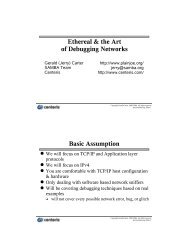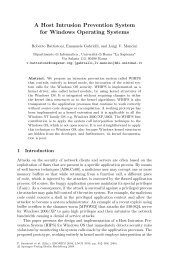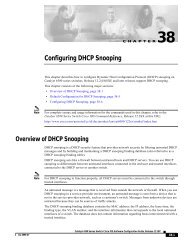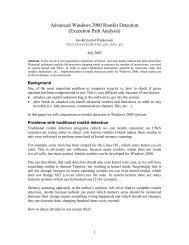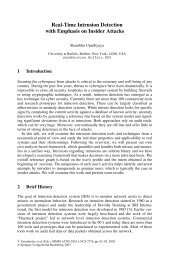ICSA Labs 10th Annual Virus Prevalence Survey 2004.pdf - Craig ...
ICSA Labs 10th Annual Virus Prevalence Survey 2004.pdf - Craig ...
ICSA Labs 10th Annual Virus Prevalence Survey 2004.pdf - Craig ...
- No tags were found...
You also want an ePaper? Increase the reach of your titles
YUMPU automatically turns print PDFs into web optimized ePapers that Google loves.
Macro <strong>Virus</strong>:<strong>ICSA</strong> <strong>Labs</strong> <strong>Virus</strong> <strong>Prevalence</strong> <strong>Survey</strong> 2004Master Boot Record:A virus which consists of instructions in Word Basic, Visual Basic for Applications (VBA), orsome other macro language, and resides in documents. While we do not think of documents ascapable of being infected, any application that supports automatically-executing macros is apotential platform for macro viruses. Because documents are now more widely shared thandiskettes (through networks and the Internet), document-based viruses are likely to dominateour future.The 340-byte program located in the Master Boot Sector. This program begins the bootprocess. It reads the partition table, determines what partition will be booted from (normallyC:), and transfers control to the program stored in the first sector of that partition, which is theBoot Sector. The Master Boot Record is often called the MBR, and often called the “masterboot sector” or “partition table.” The master boot record is created when FDISK or FDISK/MBR is run.Master Boot Sector: The first sector of the hard disk to be read. This sector is located on the top side (“side 0”),outside cylinder (“cylinder 0”), first sector (“sector 1.”) The sector contains the Master BootRecord.Master Boot Sector <strong>Virus</strong>: A virus that infects the master boot sector, such as NYB, spreads through the boot sector offloppy disks. If you boot or attempt to boot your system with an infected floppy disk, NYBloads into memory and then writes itself to the master boot sector on the hard drive. If the diskis not bootable, you see the DOS error message, “Non-system disk or disk error...”. If the diskis bootable, the system boots to the A: prompt. Either way the system is infected, and there isno indication on the screen that this has happened. Once the hard drive is infected, NYB loadsinto memory each time the system is booted. The virus stays in memory, waiting for DOS toaccess a floppy disk. It then infects the boot record on each floppy DOS accesses.On-Demand Scanning:Polymorphic <strong>Virus</strong>:Remove:Resident:Stealth <strong>Virus</strong>:Trojan Horse:Worm:Zoo <strong>Virus</strong>:Synonyms: offline, manual scanning, foreground, non-resident scanning, scanning.A polymorphic virus is one that produces varied, yet fully operational, copies of itself in thehope that virus scanners will not be able to detect all instances of the virus.To remove or clean a virus means to eliminate all traces of it, returning the infected item to itsoriginal, uninfected state. Nearly all viruses are theoretically removable by reversing theprocess by which they infected. However, any virus that damages the item it has infected bydestroying one or more bytes is not removable, and the item needs to be deleted and restoredfrom backups in order for the system to be restored to its original, uninfected state. There is agap between theory and practice. In practice, a removable virus is one that the anti-virusproduct knows how to remove. The term “clean” is sometimes used for remove, andsometimes used to refer to the destruction of viruses by any method. Thus deleting a file that isinfected might be considered cleaning the system. We do not regard this as an appropriate useof the term “clean.”A property of most common computer viruses and all background scanners and behaviorblockers. A resident virus is one that loads into memory, hooks one or more interrupts, andremains inactive in memory until some trigger event. When the trigger event occurs, the virusbecomes active, either infecting something or causing some other consequence (such asdisplaying something on the screen.) All boot viruses are resident viruses, as are the mostcommon file viruses. Macro viruses are non-resident viruses.A virus that uses any of a variety of techniques to make itself more difficult to detect. Astealth boot virus will typically intercept attempts to view the sector in which it resides, andinstead show the viewing program a copy of the sector as it looked prior to infection. Anactive stealth file virus will typically not reveal any size increase in infected files when youissue the “DIR” command. Stealth viruses must be “active” or running in order to exhibit theirstealth qualities.A program that does something unwanted and unexpected by a user, but intended by theprogrammer. Trojans do not make copies of themselves, as do viruses, and seem to be morelikely to cause damage than viruses.Similar to a virus in that it makes copies of itself, but different in that it need not attach toparticular files or sectors at all. Once a worm is executed, it seeks other systems to infect, thencopies its code to them.A virus which is rarely reported anywhere in the world, but which exists in the collections ofresearchers.Copyright 2005 <strong>ICSA</strong> <strong>Labs</strong>, a division of Cybertrust, Inc. All Rights Reserved.This information may not be incorporated into any other work and may be reproduced only with the express written permission of Cybertrust, Inc.Page 33



